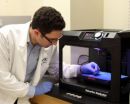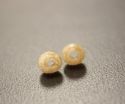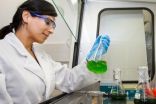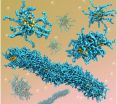(Press-News.org) RUSTON, La. – A team of researchers at Louisiana Tech University has developed an innovative method for using affordable, consumer-grade 3D printers and materials to fabricate custom medical implants that can contain antibacterial and chemotherapeutic compounds for targeted drug delivery.
The team comprised of doctoral students and research faculty from Louisiana Tech's biomedical engineering and nanosystems engineering programs collaborated to create filament extruders that can make medical-quality 3D printing filaments. Creating these filaments, which have specialized properties for drug delivery, is a new concept that can result in smart drug delivering medical implants or catheters.
"After identifying the usefulness of the 3D printers, we realized there was an opportunity for rapid prototyping using this fabrication method," said Jeffery Weisman, a doctoral student in Louisiana Tech's biomedical engineering program. "Through the addition of nanoparticles and/or other additives, this technology becomes much more viable using a common 3D printing material that is already biocompatible. The material can be loaded with antibiotics or other medicinal compounds, and the implant can be naturally broken down by the body over time."
According to Weisman, personalized medicine and patient specific medication regiments is a current trend in healthcare. He says this new method of creating medically compatible 3D printing filaments will offer hospital pharmacists and physicians a novel way to deliver drugs and treat illness.
"One of the greatest benefits of this technology is that it can be done using any consumer printer and can be used anywhere in the world," Weisman said.
Weisman, who works out of a lab directed by Dr. David K. Mills, professor of biological sciences and biomedical engineering, partnered with Connor Nicholson, a doctoral candidate in nanosystems engineering and member of a lab operated by Dr. Chester Wilson, associate professor of electrical and nanosystems engineering, to develop the technology in collaboration with Mills. The group also worked with Extrusionbot, LLC of Phoenix, Arizona, who provided important materials support throughout the development and testing process.
"We had been working on several applications of 3D printing," said Mills. "Several students in my lab including Jeff and Connor, who was a guest researcher from Dr. Wilson's lab, had been working with colleagues for some time. I sent an email to them and asked them the question, 'Do you think it would be possible to print antibiotic beads using some kind of PMMA or other absorbable material?'"
From that point, the technology evolved and has become a highly innovative approach to overcoming many of the limitations encountered in current drug delivery systems. Most of today's antibiotic implants, or "beads," are made out of bone cements which have to be hand-mixed by a surgeon during a surgical procedure and contain toxic carcinogenic substances. These beads, which are actually a type of Plexiglas, do not break down in the body and require additional surgery for removal. Weisman and his team's custom 3D print filaments can be made of bioplastics which can be resorbed by the body to avoid the need for additional surgery.
The nature of the 3D printing process developed at Louisiana Tech allows for the creation of partially hollow beads that provide for a greater surface area and increased drug delivery and control. Localized treatment with the 3D printed antibiotic beads also avoids large systemic drug dosages that are toxic and can cause damage to a patient's liver and kidneys.
"Currently, embedding of additives in plastic requires industrial-scale facilities to ensure proper dispersion throughout the extruded plastic," explains Mills. "Our method enables dispersion on a tabletop scale, allowing researchers to easily customize additives to the desired levels. There are not even any industrial processes for antibiotics or special drug delivery as injection molding currently focuses more on colorants and cosmetic properties."
"It is truly novel and a worldwide first to be 3D printing custom devices with antibiotics and chemotherapeutics."
The team said the environment at Louisiana Tech played a large role in this project making the progress it has, in a relatively short period of time. "The project has been able to advance to this point because of the support of and easy access to interdisciplinary facilities and outstanding faculty such as Drs. Mills, Wilson and [Dr. Mark] DeCoster," said Weisman. "They and their labs have been crucial in taking cell culture and chemotherapeutic related aspects of this project to the next level"
"It is important to continue support of this research and to help bring Louisiana Tech to the forefront of rapid prototyping designs that will have impacts on a national scale."
INFORMATION: END
Louisiana Tech University researchers use 3D printers to create custom medical implants
Breakthrough technology creates materials infused with cancer-fighting drugs, antibiotics
2014-08-21
ELSE PRESS RELEASES FROM THIS DATE:
Water and sunlight the formula for sustainable fuel
2014-08-21
An Australian National University (ANU) team has successfully replicated one of the crucial steps in photosynthesis, opening the way for biological systems powered by sunlight which could manufacture hydrogen as a fuel.
"Water is abundant and so is sunlight. It is an exciting prospect to use them to create hydrogen, and do it cheaply and safely," said Dr Kastoori Hingorani, from the ARC Centre of Excellence for Translational Photosynthesis in the ANU Research School of Biology.
Hydrogen offers potential as a zero-carbon replacement for petroleum products, and is already ...
Researchers develop models to study polyelectrolytes, including DNA and RNA
2014-08-21
Researchers from North Carolina State University have developed a novel and versatile modeling strategy to simulate polyelectrolyte systems. The model has applications for creating new materials as well as for studying polyelectrolytes, including DNA and RNA.
"Our new technique allows us to model much larger and more complex polyelectrolyte systems, and to do so much more quickly," says Nan Li, lead author of a paper on the work and a Ph.D. student in NC State's Department of Materials Science and Engineering. "This is a big step forward for this field."
Polyelectrolytes ...
Adherence to diet can be measured from blood
2014-08-21
New results from the Nordic SYSDIET study show that it's possible to assess dietary compliance from a blood sample. This is especially useful in controlled dietary intervention studies investigating the health benefits of specific diets. So far, such studies have mainly relied on the participants' self-reported dietary intake, which is often biased, making it more difficult to assess the real health benefits.
In the recently published study authored by Dr Matti Marklund and coworkers, the researchers were able to identify the study participants with the greatest apparent ...
A novel pathway for prevention of heart attack and stroke
2014-08-21
Finnish researchers have found that the low-expression variant of fatty acid-binding protein 4 (FABP4), which is particularly common among Finns, reduces the risk of heart attack and stroke. The finding revealed a promising new way to customise a potentially preventive drug for atherosclerosis.
Led by Professor Perttu Lindsberg, the long-term research project of the Department of Neurology at the Hospital District of Helsinki and Uusimaa (HUS) focuses on carotid atherosclerosis. It is a joint effort involving the University of Helsinki, the Helsinki University Central ...
Feeling bad at work can be a good thing (and vice versa)
2014-08-21
LIVERPOOL, UK – 05 August 2014: Research by the University of Liverpool suggests that, contrary to popular opinion, it can be good to feel bad at work, whilst feeling good in the workplace can also lead to negative outcomes.
In a Special Issue published in Human Relations, Dr Dirk Lindebaum from the University's Management School, together with his co-author Professor Peter Jordan, developed a new line of study, and commissioned research to further explore the role of emotions in the workplace.
They found that the commonly-held assumption that positivity in the workplace ...
Counselling has limited benefit on young people drinking alcohol
2014-08-21
Counselling techniques used to help young people with drinking problems may be of limited benefit, a new study suggests. In a systematic review published in The Cochrane Library, researchers found that an approach known as motivational interviewing did not substantially reduce drinking or alter alcohol-related behaviour.
Globally every year, around 320,000 young people between the ages of 15 and 29 die as a result of alcohol misuse. Most of these deaths are due to car accidents, murders, suicides or drowning. Motivational interviewing is a counselling technique developed ...
Regular blood transfusions can stave off repeat strokes in children with sickle cell disease
2014-08-21
Monthly blood transfusions can substantially reduce the risk of recurrent strokes in children with sickle cell disease (SCD) who have already suffered a silent stroke, according to the results of an international study by investigators at the Johns Hopkins Children's Center, Vanderbilt University and 27 other medical institutions.
Results of the federally funded research described in the Aug. 21 issue of The New England Journal of Medicine, show that children with preexisting silent strokes who receive monthly transfusions have 58 percent lower risk of suffering repeat ...
NEJM Perspective: 'Studying 'Secret Serums' -- Toward Safe, Effective Ebola Treatments'
2014-08-21
WASHINGTON – Conducting clinical studies of agents to treat Ebola and allowing compassionate use of those agents are not necessarily mutually exclusive, writes Georgetown University Medical Center's (GUMC) Jesse L. Goodman, M.D., M.P.H., in a perspective piece published Wednesday in the New England Journal of Medicine.
In "Studying 'Secret Serums' — Toward Safe, Effective Ebola Treatments," Goodman describes the Ebola virus as "one of the world's most feared pathogens." The latest Ebola outbreak that began in West Africa in Dec. 2013 has infected more than 2,200 people ...
Imaging study reveals white-matter deficits in users of codeine-containing cough syrups
2014-08-20
Aug. 20, 2014 -- An imaging study of chronic users of codeine-containing cough syrups (CCS) has found deficits in specific regions of brain white matter and associates these changes with increased impulsivity in CCS users.
Researchers used diffusuion tensor imaging (DTI) (an MR imaging technique), coupled with fractional anisotropy, to investigate the white matter integrity of chronic CCS users. Deficits were found in multiple regions of the brain, including the inferior fronto-occipital fasciculus, which other studies have found to be abnormal in other forms of addiction, ...
High school students discover stars at SMU research program
2014-08-20
DALLAS (SMU) – Two Dallas high school students discovered five stars as members of a Southern Methodist University summer physics research program that enabled them to analyze data gleaned from a high-powered telescope in the New Mexico desert.
All five stars discovered by Lake Highlands High School seniors Dominik Fritz and Jason Barton are eclipsing contact binary stars, pairs of stars that orbit around each other so closely that their outer atmospheres touch. As the stars eclipse, they dim and then brighten as one emerges from behind the other. These stars are categorized ...
LAST 30 PRESS RELEASES:
Chicago health information leader recognized for raising CPR readiness and blood pressure awareness
The Intimate Animal, a new book from Kinsey Institute Executive Director Dr. Justin Garcia
When blue-collar workers lose union protection, they try self-employment
New video dataset to advance AI for health care
MEA-based graph deviation network for early autism syndrome signatures in human forebrain organoids
New modeling approach sheds light on rare gut disease
Study documents potentially hazardous flame retardants in firefighter gear
Can certain bacteria regulate aging of the immune system and its related alterations?
AI model helps diagnose often undetected heart disease from simple EKG
There are fewer online trolls than people think
Cell membrane fluctuations produce electricity
Jeonbuk National University study shows positive parenting can protect adolescents against self-harm
Surface-engineered ZnO nanocrystals to tackle perfluoroalkyl substance contamination
This new understanding of T cell receptors may improve cancer immunotherapies
A new fossil face sheds light on early migrations of ancient human ancestor
A new immunotherapy approach could work for many types of cancer
A new way to diagnose deadly lung infections and save lives
40 percent of MRI signals do not correspond to actual brain activity
How brain-inspired algorithms could drive down AI energy costs
Gum disease may be linked to plaque buildup in arteries, higher risk of major CVD events
Contrails are a major driver of aviation’s climate impact
Structure of dopamine-releasing neurons relates to the type of circuits they form for smell-processing
Reducing social isolation protects the brain in later life
Keeping the heart healthy increases longevity even after cancer
Young adults commonly mix cannabis with nicotine and tobacco
Comprehensive review illuminates tau protein's dual nature in brain health, disease, and emerging psychiatric connections
Book prepares K-12 leaders for the next public health crisis
Storms in the Southern Ocean mitigates global warming
Seals on the move: Research reveals key data for offshore development and international ecology
Sports injuries sustained during your period might be more severe
[Press-News.org] Louisiana Tech University researchers use 3D printers to create custom medical implantsBreakthrough technology creates materials infused with cancer-fighting drugs, antibiotics



